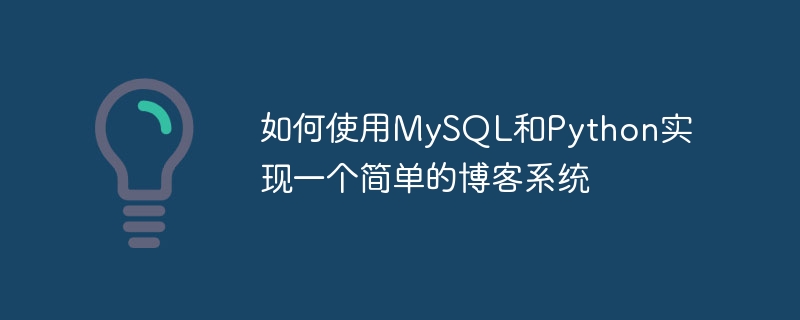

MySQL と Python を使用して単純なブログ システムを実装する方法
この記事では、MySQL と Python を使用して単純なブログ システムを作成します。 MySQL を使用して、ブログのタイトル、内容、著者、公開日などのブログのデータを保存します。 Python をバックエンド言語として使用してデータベースとの対話を処理し、ブログを管理および表示するためのシンプルなユーザー インターフェイスを提供します。
まず、MySQL と Python の関連する依存関係ライブラリをインストールする必要があります。次のコマンドを使用してインストールできます:
pip install mysql-connector-python
次に、ブログのデータを保存するための「blog」という名前のデータベースと「posts」という名前のテーブルを作成します。次のコードを使用して作成できます。
import mysql.connector
# 连接MySQL数据库
mydb = mysql.connector.connect(
host="localhost",
user="yourusername",
password="yourpassword"
)
# 创建数据库
mycursor = mydb.cursor()
mycursor.execute("CREATE DATABASE blog")
# 使用数据库
mycursor.execute("USE blog")
# 创建博客表格
mycursor.execute("CREATE TABLE posts (id INT AUTO_INCREMENT PRIMARY KEY, title VARCHAR(255), content TEXT, author VARCHAR(255), publish_date DATE)")これで、Python コードの作成を開始する準備が整いました。ブログのデータを管理するためのいくつかのメソッドを含む単純な Blog クラスを作成します。
import mysql.connector
class Blog:
def __init__(self, host, user, password, database):
# 连接MySQL数据库
self.mydb = mysql.connector.connect(
host=host,
user=user,
password=password,
database=database
)
# 创建游标对象
self.mycursor = self.mydb.cursor()
def create_post(self, title, content, author, publish_date):
# 插入博客数据到数据库
sql = "INSERT INTO posts (title, content, author, publish_date) VALUES (%s, %s, %s, %s)"
val = (title, content, author, publish_date)
self.mycursor.execute(sql, val)
# 提交事务
self.mydb.commit()
def get_all_posts(self):
# 查询所有博客数据
self.mycursor.execute("SELECT * FROM posts")
result = self.mycursor.fetchall()
# 返回查询结果
return result
def get_post_by_id(self, post_id):
# 根据博客ID查询数据
self.mycursor.execute("SELECT * FROM posts WHERE id = %s", (post_id,))
result = self.mycursor.fetchone()
# 返回查询结果
return result
def update_post(self, post_id, title, content, author, publish_date):
# 更新博客数据
sql = "UPDATE posts SET title = %s, content = %s, author = %s, publish_date = %s WHERE id = %s"
val = (title, content, author, publish_date, post_id)
self.mycursor.execute(sql, val)
# 提交事务
self.mydb.commit()
def delete_post(self, post_id):
# 删除博客数据
self.mycursor.execute("DELETE FROM posts WHERE id = %s", (post_id,))
# 提交事务
self.mydb.commit()これで、このブログ クラスを使用してブログを管理できるようになります。以下は簡単な例です:
blog = Blog("localhost", "yourusername", "yourpassword", "blog")
# 创建博客
blog.create_post("第一篇博客", "这是我的第一篇博客内容", "作者A", "2021-01-01")
# 获取所有博客
posts = blog.get_all_posts()
for post in posts:
print(post)
# 获取指定ID的博客
post = blog.get_post_by_id(1)
print(post)
# 更新博客
blog.update_post(1, "更新后的博客标题", "更新后的博客内容", "作者B", "2021-02-01")
# 删除博客
blog.delete_post(1)上記のコードは単なる例であり、必要に応じて変更および拡張できます。たとえば、フィールドを追加して、ブログのタグやページビューなどの情報を保存できます。ユーザー認証や権限管理機能を追加して、ブログシステムのセキュリティを強化することもできます。
この記事が、MySQL と Python を使用して簡単なブログ システムを実装する方法を理解するのに役立つことを願っています。ご質問がございましたら、コメント欄に残していただければ、できる限りお答えさせていただきます。
以上がMySQL と Python を使用して簡単なブログ システムを実装する方法の詳細内容です。詳細については、PHP 中国語 Web サイトの他の関連記事を参照してください。